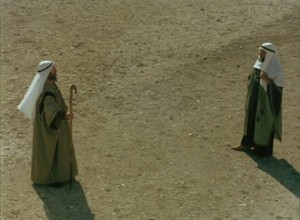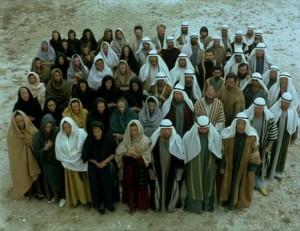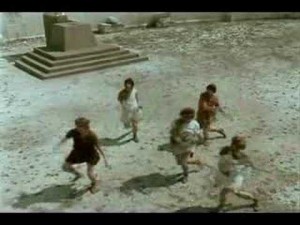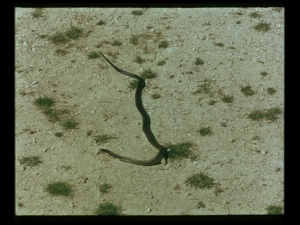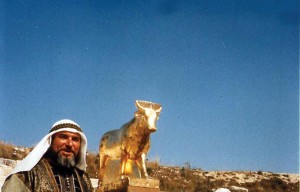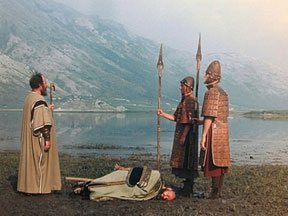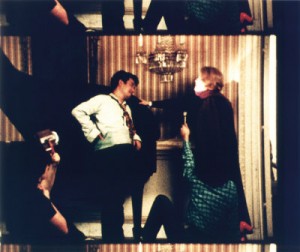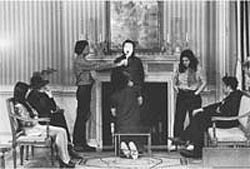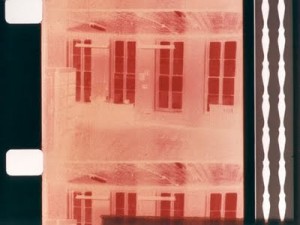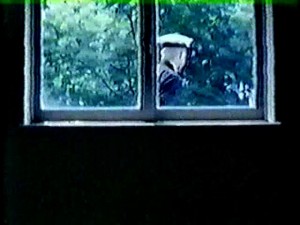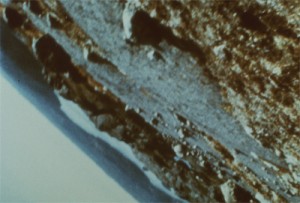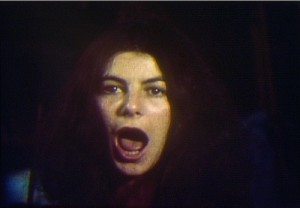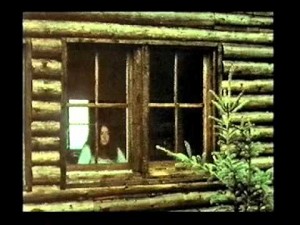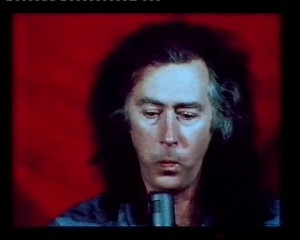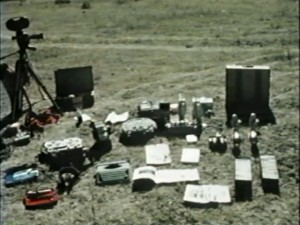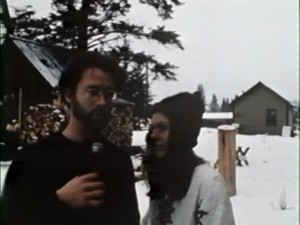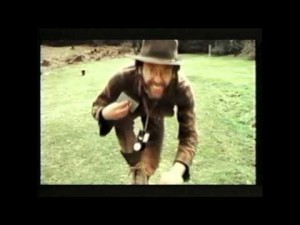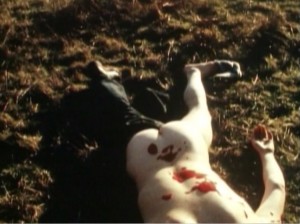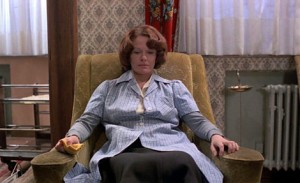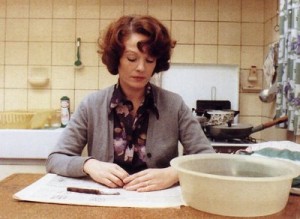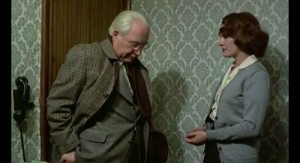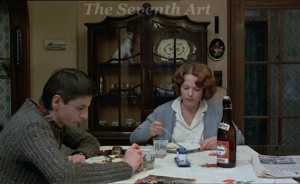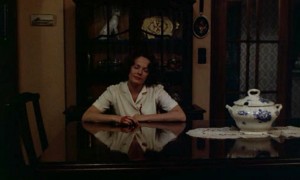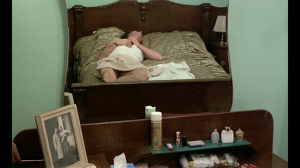From Sight and Sound, Winter 1975/1976; also reprinted in my first collection, Placing Movies: The Practice of Film Criticism. — J.R.
Edinburgh Encounters:
A Consumers/Producers Guide-in-Progress to Four Recent Avant-Garde Films
The role of a work of art is to plunge people into horror. If the artist has a role, it is to confront people — and himself first of all — with this horror, this feeling that one has when one learns about the death of someone one has loved.
— Jacques Rivette interview, circa 1967
For interpersonal communication, [the modernist text] substitutes the idea of collective production; writer and reader are indifferently critics of the text and it is through their collaboration that meanings are collectively produced . . .
The text then becomes the location of thought, rather than the mind. The mind is the factory where thought is at work, rather than the transport system which conveys the finished product. Hence the danger of the myths of clarity and transparency and of the receptive mind; they present thought as prepackaged, available, given, from the point of view of the consumer . . .Within a modernist text, however, all work is work in progress, the circle is never closed. Incompatible elements in a text should not be ironed out but confronted.
— Peter Wollen, Signs and Meaning in the Cinema, rev. ed., 1972
Are these two statements contradictory or complementary? The former describes art in visceral terms, as mutual emotional devastation; the latter in intellectual terms, as mutually “indifferent” criticism and production of meaning. But both, in a way, are temperamentally different descriptions of a process that might be regarded as the same. If the first prerequisite of an avant-garde work is that it makes one nervous — disrupting a familiar pattern of consumption, creating a sense of loss or absence which must be filled by the consumer’s initiative — the second could be that it somehow rewards productive efforts to come to terms with it.
Since the responsibility for both conditions rests with work and consumer alike, it stands to reason that acceptance without conflict and rejection without compunction are the least productive responses to avant-garde films that can be imagined. Yet broadly speaking, the polarization today between defenders and detractors is such that no other public stances are readily acknowledged. To oversimplify somewhat, one faction is play-acting while the other is fleeing in terror.
These stances take the form of two kinds of rhetoric, each of which ignores and alienates the other. “Inside” critics with the benefit of theoretical contexts and larger funds of background information — some of it gossipy and anecdotal, some of it contextual and crucial — usually devote their energies to describing and discussing the text of a work, the concrete elements composing it. “Outside” critics, often limited by less information and more journalistic constraints, are more concerned with their subjective experiences. Thus the insider fails to address or even acknowledge private experience, leaving the uninitiated out in the cold; the outsider, conversely, makes his own experience public while remaining relatively cavalier about the text, effectively banishing the film itself.
The presumption I have adopted for the present context is that “avant-garde” can only be defined in relation to the beholder: whether or not it causes enough discomfort to push one forward. If a spectator finds WAVELENGTH as easy or as automatic to read as a Western, then he isn’t watching an avant-garde film; if he is a film novice encountering a SUNRISE or a CITIZEN KANE for the first time, he conceivably might be. Any “reading” (definition, discussion, or experience) of a modernist work entails a perpetual dialogue between spectator and text, and I have attempted to bear witness to this process in the formula devised for dealing with the films treated below. All four were screened during the Edinburgh Festival late last August, and I have referred to this context whenever it has seemed relevant.
Feeling myself to occupy a certain middle ground between the vantage points of insider and outsider, producer and consumer, I have made my remarks deliberately confessional and provisional to the point of embarrassment, in an effort to demystify, if I can, some of the more rigid attitudes outlined above. I have been particularly interested in charting some of the means by which my own biases, engagements, disengagements, and evaluations have been formed. Limited by single screenings and/or restrictions of space and time, I cannot give these films’ texts the kind of close scrutiny that is due to them (which is why I have suggested supplementary texts whenever possible); the same applies to my experiences, all of which are still in progress.
MOSES UND ARON (Straub/Huillet)
Expectations: There are probably no filmmakers alive who intimidate me more than the team of Straub and Huillet. I can’t believe anyone who describes their works as “easy to take”: easy to consume, perhaps, on a strictly material level — I’m always excited by their use of direct sound and intrigued by the camera movements which appear to counter this openness, as didactic and final in their effects as Lang’s reverse angles. But it’s no summer picnic when it comes to reading and coproducing their texts. My usual experience combines an unrigorous respect for what they are doing with a frustrated sense of straggling behind them, which leads me to regard them as utopians aiming their films at “ideal” spectators who don’t yet exist.
It’s not merely a matter of following, say, the plots of NICHT VERSÖHNT and OTHON without prior knowledge of the Böll and Corneille texts which they utilize; I also have the more immediate problem of assimilating the spoken texts of CHRONICLE OF ANNA MAGDALENA BACH and HISTORY LESSONS in the time spans allotted me, particularly after the musical performances in the former and the car rides in the latter have slowed my motor impulses down to a more contemplative gait. And turning to Straub/Huillet’s interviews, I’m again confronted with nearly equal amounts of admiration and confusion. Clearly they’re alive to much of the best in cinema, and their theoretical articulations usually make me feel guilty for not reading more Marx and Engels. But when they proceed to enumerate precise reasons for all that they do, I often find myself split between fascination with these details — as ingenious, autonomous critiques in their own right — and dismay that they seldom correspond to my own readings of the films.
Case in point: at a delightfully good-natured and informative public discussion in Edinburgh, Danièle Huillet parenthetically notes that the sections of black leader punctuating the recitation of Schoenberg’s second letter to Kandinsky in INTRODUCTION TO THE ACCOMPANIMENT TO A CINEMATOGRAPHIC SCENE BY ARNOLD SCHÖNBERG are introduced to mark elisions in the text. I’ve seen the short twice, and spent some time pondering the function of those black strips of film: rhythmic, ideological, formal, a kind of distanciation, or merely arbitrary? Some would argue that it doesn’t matter; but the strongest impact of any Straub/Huillet film, it seems to me, is that everything matters.
I’m glad to have Huillet’s explanation, but I also question the ultimate usefulness of my former blind alleys. Being thrown back on one’s habits and resources is valuable if something grows out of the confrontation, but in this case — and comparable ones could be cited in their work — I feel as if I’d been sent out on a singularly unenlightening ride around the block. If, as they frequently state, Huillet/Straub dream of showing their films to factory workers, do they intend to bring along notes explaining such procedures?
Responses to Text: Their film of MOSES UND ARON is my initial encounter with the Schönberg opera, and from the moment the music begins I am grateful for having had this innocence. For the first time in any film, I have the sensation of listening to a piece of music without any kind of interference. This isn’t true in the Bach film, which obliges one to watch musicians performing in an overall context of “work.” Here we see the singers performing live and, along with them, hear the offscreen prerecorded orchestra (facts I heard about before the screening), and in no way do the pans or cuts or actors’ movements contrive to interpret the music (although they do interpret the libretto). Furthermore, natural sounds of footsteps, breathing, and other movements are so beautifully captured along with the music that I know in advance that Gielen’s separate recording of the opera will always sound somewhat incomplete, at least as a soundtrack score. This is the anti-FANTASIA par excellence; and long before the film arrives at the Golden Calf in act 2, it becomes clear that this is an anti-DeMille approach to spectacle as well.
But a question presents itself about the revels staged around this calf. If Moses represents Idea and Aron stands for Image, one might suppose that their conflict would become most intense when Desire rears its orgiastic head. Elsewhere, the voices of the burning bush have been kept offscreen so that (as Straub later explains), after the camera is panning up from Moses and across the landscape, these voices will subsequently seem to be those of “The People,” who appear two scenes later as the chorus — a subversive turnaround of the material indeed. The miracle of the staff becoming a snake has been similarly transformed by cutting from one to the other rather than resorting to any trickery, while the Pillar of Fire becomes the sudden increase in light over a landscape brought about by a passing cloud. But when we get to the orgy, images of desire, passion, and bloodshed are so radically stripped of potential resonance that it seems the Calf’s temptations aren’t even getting a decent look-in. On the other hand, this is where I find the music most exciting and expressive, which makes me reconsider these tactics. Accompanying the musical fury with nude bodies, dancing, and violence that in no way compete with or duplicate any of its power may be the best possible way of serving it; who else in cinema would have really left Schönberg’s music alone?
Act 3 — spoken by Moses and Aron, without music — is striking but enigmatic. Filmed in one take, it begins with Aron at the feet of Moses and two soldiers in long shot, a towering vista of mountain and lake behind them, and ends with Moses in close-up.
Afterthoughts: Immediately after the screening, I’m told that according to Schönberg’s instructions, Aron is supposed to drop dead after Moses sets him free. Straub “explains” this later in the public discussion by noting that at the end of the film Moses and Aron have destroyed one another (“They are simply two aspects of the same thing”) and only The People are left — a fact I can accept and understand ideologically but not materially, because the film doesn’t end that way.
In many respects, my work on the film has scarcely begun. Buying the recording and listening to it with the libretto in German and English, seeing the film again in Paris and taking notes, matching these notes with both the libretto and a copy of the script in German, have all been enlightening projects. One cannot appreciate a great deal of the film properly unless one has read Schönberg’s stage directions and then seen how they have or haven’t been followed. When, for example, it is indicated that “From the audience Moses and Aron . . . appear to change their respective positions” — with Moses shifting from foreground to background to foreground, and Aron vice versa — this transition is effected by one elaborate camera movement. Like many other details, it makes me think that Straub/Huillet aren’t so much “minimalists” (as they’re often called) as “essentialists” . . .Whatever my qualms about their stimulating statements regarding what should be evident in the film (and isn’t), the deeper that I delve into its textures, the richer it becomes.
Suggested: Interview with Straub and Huillet (Cahiers du Cinéma, no. 258–259), script of MOSES UND IRON (Filmkritik, May–June 1975), Michael Gielen’s recording of the opera (with libretto) on Phillips.
Rameau’s Nephew by Diderot (Thanx to Dennis Young) by Wilma Schoen (Michael Snow)
Expectations: Even though a New York friend warned me some months ago that this nearly five-hour film doesn’t have the seductive qualities of Snow’s earlier work, there’s nothing at Edinburgh that I’m more curious or anxious to see. Speaking of “seduction” in relation to WAVELENGTH, BACK AND FORTH, and THE CENTRAL REGION may raise some smiles among those readers who shun them like the bubonic plague — a group that may well constitute the majority. But seductive, provocative, challenging, eye-opening, and mindbending they certainly are, if only one can profitably get past the point of realizing that Snow has brought possibilities and points of reference to cinema that it never had before.
Large claims, to be sure; yet the beauty and terror of Snow’s films are both essential functions of this uniqueness. The route of a cinéphile into the work of Godard, Rivette, and Straub is largely predicated on the experience and knowledge these men have of film history — informed by a history of taste, one might add, which is basically common to all three. For me, Straub’s claim to interest is immediately enhanced by his enthusiasm for Renoir’s LA NUIT DU CARREFOUR and Mizoguchi, his appreciations of Griffith and Ford. By contrast — and speaking still from a limited cinéphile viewpoint — Snow’s films effectively come out of nowhere and “refer back” to nothing. And because his formation largely can be traced back through his work in painting and sculpture (along with his career as a free-jazz musician and his work in animation for TV commercials with George Dunning, Richard Williams, and others), certain art journals have shown more interest in him than most film magazines.
Snow’s three earlier features are based on the consequences of inexorable camera movements: a gradual zoom across an 80-foot loft; horizontal (and eventually vertical) pans swiveling “back and forth” across parts of a classroom; 360-degree rotations of a camera scanning a spectacular vista of sky, rocks, and mountains. The challenge in each case is to determine just what one is to do in relation to these relentless trajectories. Adventures and lessons in the potentialities of perception, their liberating power is to reveal that there is much more to do — to see, grasp, and come to terms with — than one initially supposes.
The progress of the zoom in WAVELENGTH, punctuated by fragments of an implied storyline (including a mysterious death and its later discovery) and informed by a sense of finite destination ( the opposite wall), entails a mixture of narrative suspense and a more “painterly” response to shifting aspects of light, color, texture, and visual field. BACK AND FORTH turns most of its potential narrative elements (the intermittent presence and activity of people) into painterly subjects while sending its inanimate objects into paroxysms of movement (as in one rapid section, where the accelerated scannings of a row of windows appear successive rather than adjacent, like flickering movie frames). Continuous movement and a total lack of human presence in THE CENTRAL REGION establishes tensions between a gradually unfolding “landscape painting” and the kinetic sensation of losing one’s center of gravity in an experience roughly akin to riding a demonic ferris wheel. In each film, one can either “follow” the camera movement or work out one’s own looking/seeing/ staring/gazing patterns in opposition to it: either procedure leads to a different set of problems, and throughout one is participating in a dialectic which illuminates at every stage.
Although sound usually plays only a subsidiary role in these films — duplicating in some mechanical rhythmic fashion the operations of the camera and/or supplementing the presence of people “realistically” — Snow’s new work is said to be devoted to relationships between sound and image.
Responses to Text: And so it is. Over 285 minutes and twenty-four sections of varying lengths separated by flashes of colors. RAMEAU’S NEPHEW focuses its attention on little else. And that, indeed, is what I find most disconcerting — a sense of reductiveness in relation to the preceding films. In one respect, Snow’s estrangement from the “dominant” film tradition makes itself felt negatively here. In the Edinburgh festival booklet, he refers to “image-sound relationships in the cinema” as a “fabulous practically uncharted artistic area.” Practically uncharted indeed, if one excludes Bresson, Dovzhenko, Dreyer, Eisenstein, Godard, Hanoun, Mizoguchi, Ozu, Pollet, Portabella, Pudovkin, Renoir, Resnais, Rivette, Sternberg, Straub, Tati, and Welles, among others.
To be fair, he isn’t pursuing this concern in a narrative context, which does make for substantial differences. But the seemingly arbitrary order of most sections leads me to regard them more as an interrelated collection of shorts than as a sustained experience, which raises the question of why one has to take it all in one serving . . . Space limitations make it impossible to describe every section, so I’ll restrict myself to the rudiments of a few which seem most amusing or interesting:
No. 4, the credit sequence: superimposed over a passing train, a long succession of names drifts upward while a stammering voice reads them off, occasionally corrected by Snow’s voice when the pronunciation is wrong. We get title, dedication (to Alexander Graham Bell), and a “cast” of over one hundred fifty names, some quite nonsensical (Lemon Coca Wish, Nice Slow Ham, Malice Shown, Show Me a Ling); meanwhile, one’s attention playfully stammers between following the spoken words and those on the screen as they go in and out of synch with one another.
7, a long sequence inside an airplane, comes closest to resembling earlier Snow by following disconnected phrases spoken by various people with fast pans away from them, separated by jump cuts; this one, too, keeps you on your toes. The verbiage is a mixture of clichés, puns, jokes, statements about language, nonsense (“Vivaldi was a big influence on Johann Sebastian Fuck”); finally, moving back in time, one hears Snow offscreen instructing each person on what to say.
8 shows two hands beating the sides of a sink like bongos, continuing as it is filled with water and then emptied. The sound is so close to that of bongos that I wonder if dubbing is involved; if so, it’s a skillful job indeed, and the bongo playing isn’t bad either.
12 has the camera zooming away from another camera to reveal a group of people sitting around it, babbling incomprehensibly (tape manipulations?); eventually the image is reversed and the shot is run backward, the dialogue now becoming only semi-incomprehensible (something about a bad smell).
16, a delightful bit, juxtaposes the rearrangement by hand of numerous objects on a desk (including a copy of Rameau’s Nephew in Penguin) with a voice describing these actions: again, like 4, a dance of variations as the one gradually strays behind or ahead of the other.
19, wordless, shows Joyce Wieland (Snow’s wife) at the window of a cabin. A loud noise sounding (to me) rather like a wheelbarrow pushed over gravel starts up, and one becomes aware of a sheet of glass in front of the window that is now becoming streaked and obscured by raindrops. Is it in fact rain that one hears? An interesting demonstration of relative surfaces, and sight helping to identify sound.
Among the games played in other sections are multiple superimpositions of sound and image, recited texts from various sources (including Mao), a disembodied voice in an office, certain words of dialogue replaced by guitar strums followed by images of guitar strums shown silent, syllables synchronized with strokes of a violin, and a wonderful MURIEL-like mosaic of shots accompanying the successive syllables of a story being recited (too bad I can’t follow the story as well). A jokey leitmotif recurring throughout the film — critic P. Adams Sitney holds forth on it in section 22 — is that each time the words 4, four, for, or fore occur visually or aurally, a separate shot acknowledges the total of these appearances to date.
As the reference in the title to Diderot suggests, Snow’s aspiration appears to be encyclopedic. In parts, I find it intriguing; in toto, indigestible. Encyclopedias are useful things to have around, but who wants to plough through from A to Z in a single sitting?
Afterthoughts: I speak with Snow after the screening, and he clarifies a number of points: 8 and 19 are indeed sequences in synch sound, and a central point of the former is the synch/sink pun, which eluded me. The first half of 12 has the dialogue played backwards, while the second takes the dialogue spoken phonetically backwards and reverses that . . . Peter Wollen observes that the nonsensical “cast” names — forty by my count — are all anagrams of “Michael Snow,” as is Wilma Schoen in the title. (Dennis Young, on the contrary, is alive and living in Canada, and Snow speaks of adding another shot to the film to prove that he exists; nobody I ask seems to know who he is.) Simon Field recalls his experience in helping to shoot part of sequence 10; Laura Mulvey points out that one of the texts in 21 comes from Pride and Prejudice; James Pettifer objects to the depoliticized use of a Mao text in the same sequence; Ben Brewster comments favorably on the film’s looseness, which he compares to concerts of the music of Cornelius Cardew; Tony Rayns argues that section 21 largely explains and justifies the rest of the film. Such swapping sessions are partially what makes a festival like Edinburgh so useful; certainly they can help one map out the coherence of certain films after the fact.
What still rattles me about RAMEAU’S NEPHEW is not having enough information about certain technical procedures either before or after the screening to appreciate (or identify) what Snow is doing in certain cases. And the perceptual investigation it offers is finally less stimulating than what his earlier work explores. Snow calls it a “musical comedy,” and perhaps I approached it with the wrong attitude. The shifting strategies turn much of it into a series of teasing puzzles, but beyond a certain point one can lose interest in solving them; and the implied play between sound and color never adds up to anything substantial that I can discern. While the earlier features demand to be consumed and produced whole, wasting nothing, it seems that certain sequences here, once one isolates their basic concepts, leave a lot of dead matter behind — like eggshells and orange peel in the wake of a picnic.
Suggested: Program notes by Marjorie Keller for the screening at Film Center, School of the Art Institute of Chicago, 30 May 1975 (including a detailed précis).
Speaking Directly: Some American Notes (Jon Jost)
Expectations: Virtually none.
Responses to Text: From the moment Jost traces an animated fish in the air with his finger, I suspect I may be in for some surprises, and prove to be right as well as wrong. As a very personal self-presentation, the film frequently runs me through exercises that I recall from fictional and nonfictional counterparts: Godard in the late 1960s, Jim McBride’s DAVID HOLZMAN’S DIARY and MY GIRLFRIEND’S WEDDING, Jonas Mekas’s REMINISCENCES OF A JOURNEY TO LITHUANIA. But Jost is so distinct a presence that I gradually start to accept his exercises — didactic section titles like “I-They” and “I-You,” “A Geography (Here)” and “A Geography (There)”; voice-over identifications of people and places; detailed inventories of the film’s financing and equipment — as means rather than ends, and my focus turns increasingly toward the subjects at hand: Jost himself, the film he is making. And before long it becomes apparent that he is going about his business with a rare sort of honesty, a directness of address that makes even Godard himself seem like an illusionist.
At the same time, I’m wary about the lure that can be exerted by this brand of all-American confessional — the note of cranky individualism which dictates that all the most well-worn discoveries have to be reasserted anew, like homemade appliances, as if no one had ever thought of them before. It’s the precise reverse of that assumed tradition of several centuries, languages, and ideologies lurking behind every gesture which I find in Straub/Huillet. An American and a contemporary of Jost, I’m constantly tempted to indulge in this rhetoric — what else am I doing now? — which may give me a high tolerance for it, extended further by a familiarity with the lifestyles and idioms. It’s quite different in this way from the urban, apolitical stance of Yvonne Rainer’s films — although there, too, my enjoyment is partially dictated by a prolonged exposure to self-analytical New York voices and idioms, which often make her films sound like cooler, more intellectual versions of Woody Allen and Elaine May.
So Jost’s painstaking expositions of his life, his cabin in rural Oregon, friends, acquaintances, daily habits, feelings, auto-critiques, and political convictions remind me of other lives I know, and a sensibility that stretches all the way back to Thoreau by way of Mailer and Agee that seeks to justify and bear witness to all the concrete matters at hand, the speaker first of all. But no sooner have I flashed on Thoreau after Jost has begun describing his rustic home — and gotten ready to dismiss his naive pretensions — than Jost takes up this very issue himself and proceeds to explore its ramifications in some detail.
This sort of thing happens more than once and can lead to irritation as well as respect. The combination of thoughtful earnestness and analytical rectitude imposes itself as a personality as much as a sensibility, making it quite difficult to judge film and filmmaker separately. An especially thorny instance occurs in a section devoted to Elayne, the woman he lives with, when one hears her attempts at self-expression doomed from the start by the fact that he is dictating the context. Instructed that she has to speak about herself in relation to him for the purposes of the film, she finally reverts to the text he has already prepared for her, and the effect could hardly be more devastating. Should I admire Jost for letting the distastefulness of this episode stand intact or recoil from the fact that he perpetrates it in the first place? I wind up doing a bit of both, which effectively means liking the film more and Jost less.
By the same token, I’m delighted when in another section someone named Dennis lodges a vitriolic protest against the film as a form of self-indulgence, urging the audience (me) to burn the print I’m watching or at least to leave the cinema, finally declaring that he intends to do just that on his side of the camera, by leaving the frame — which he promptly does. The paradox is that I’m delighted but don’t leave the cinema. Is Dennis being self-indulgent as well? Am I?
To Jost’s credit, he seems to have much more political sophistication than most of his peers — largely, I think, because as with everything else he tackles in this film, he takes very little for granted. Unlike a lot of Marxist rhetoric I encounter in and about cinema on both sides of the Atlantic, Jost’s political stances appear to have nothing to do with social, professional, or academic conformity, self-flattery, or coquetry, and most of his analyses teach me something.
Afterthoughts: Why then don’t I recount these lessons in some detail? The extent of Jost’s anti-illusionism prompts me to attempt a little of my own, helping me to appreciate how hard it is to get rid of artifice. In fact, I don’t recall most of his political sequences with any precision; what I mainly remember is that I was impressed at the time. My notes allude to one about Vietnam composed of an endlessly repeated film loop of American bombing accompanied by a woman’s personal testimony about tortures, heard simultaneously with a man reciting facts and figures about the U.S. involvement — none of which, I should add, taught me anything essential that I hadn’t already known. (I recognize the intention of revealing the war’s televised monotony and remoteness, but that’s nothing new either.) I also recorded some statistics that are cited elsewhere, that the United States comprises 7 percent of the world’s land, 5 percent of its population, and consumes 60 percent of its material resources. Perhaps I’d heard this before, too, but Jost nevertheless places it in a context where its meaning is renewed for me.
I’ve neglected to mention several crucial episodes, including a long sequence showing only a stopwatch on the top of a blank white frame, before a hand enters to remove it (rather like a call to silent prayer in a religious service, but I like it anyway); and various striking visual tropes, such as a very slow dissolve that shows the sun appearing in an egg yolk. As some of my selective inventory may suggest, Jost has included a little of everything to flesh out his statement; what I haven’t tried to convey, however, is the rather precise way he has structured it all. What I like most about the film is the way it lives up to its title and addresses me in the act of watching it, and not in some imaginary netherworld outside this experience.
Suggested: Articles by Julia Lesage and Jon Jost in Jump Cut, no. 5 (January–February 1975).
Jeanne Dielman, 23 Quai De Commerce — 1080 Bruxelles
(Chantal Akerman)
Expectations: Acquaintances who’ve seen this unsubtitled Belgian film at Cannes or Berlin describe it with some bemusement as a film over three hours long showing Delphine Seyrig, as the title heroine, doing a lot of mundane things like polishing shoes and washing dishes. The festival booklet notes that she kills a man “unpremeditatedly” toward the end and that the film covers a time span of two days. Akerman has made other films, but at this point I know nothing about them, apart from the fact that she has some reputation as a feminist.
Responses to Text: Seyrig/Dielman dries dishes, adds salt to potatoes on the stove. After she greets an old man at the door of her fiat, takes his coat and scarf, and goes off into another room with him, there’s an ellipsis — here, as elsewhere, covered by a straight cut. They emerge, he hands her some money (“Alors, la semaine prochaine”), and leaves. She puts the money in a ceramic pot on the dining room table, returns to the kitchen, pours out the boiling water, transfers the potatoes to another pot, takes a towel off her bed and drops it in a hamper, closes a bedroom window, turns out the light. Another ellipsis: she finishes taking a bath, dries and dresses herself, cleans the tub, sets the dining room table. A boy of sixteen or so arrives; she kisses him on the cheek, serves him soup; he reads while eating until she asks him not to. (A neon sign flashes from outside in the small adjoining living room.) She returns to the kitchen to fetch meat and potatoes, turns off the kitchen light, serves the food. “C’est bon?” “Oui, oui,” he mutters, dawdling over the food. She chides him for not eating more, removes his halfeaten plate, then takes out a letter from a friend or relative and reads it aloud, very mechanically. She gives him chewing gum . . .corrects his pronunciation while he reads Baudelaire’s “L’Ennemi” twice (significant? I doubt it) . . . turns on the radio . . . knits.
She and her son go out, take the lift down to street level, leave the building. Ellipsis; they return, take the lift back up again. She makes up his sofa-bed in the living room and they talk about her dead husband (his father); in response to questions, she remarks drily that making love with him had no importance for her apart from having a child. She goes to bed — ellipsis — gets out of bed, brings him fresh underwear, polishes his shoes, grinds coffee beans, etc., serves him breakfast, ties his scarf, gives him money from the pot in the dining room, sees him off. Folds up the sofabed, washes cutlery and dishes.
By now, I’ve used up less than a quarter of my abbreviated notes, but there’s no need to extend the rundown indefinitely. It all proceeds at the same naturalistic crawl in sharp, uninflected color (shot by Babette Mangolte), with characters always shown frontally, from behind or in profile but never in intermediate angles, and no camera movements that I can recall.
I’m neither bored (exactly) nor interested (exactly), just curious. I tend to like movies that allow me breathing space in which to think, but this one gives me so much freedom that I don’t know what to do with it — one reason, perhaps, why I take so many notes . . . The film continues to chronicle the remainder of the second day: a trip to a post office and shoe repair; she runs into a friend who invites her for coffee but she says she doesn’t have time, maybe next week. Comes home with groceries, writes a letter, takes charge of a neighbor’s baby while preparing wiener schnitzel, puts on makeup, goes out and buys yarn, drinks coffee alone in a cafe, returns home. Is drying her hands in the kitchen when the doorbell rings; greets another male customer — this one Jacques Doniol-Valcroze! — and continues through much the same patterns as the previous day.
At one point I leave the cinema for a few minutes — partially for a cigarette and partially to see what it feels like not watching the movie—and when I return, I don’t feel as if I’ve missed anything important. Yet something keeps me watching, although I’m not sure precisely what. I know that some of it is Seyrig’s performance — probably her best since MURIEL — which is remarkable for conveying almost no psychological nuances whatever; apart from her very precise movements and rituals, all perfectly executed, it is virtually impossible to guess what she’s thinking at any given moment. As with Bresson, this makes her movements more interesting rather than less, but no sort of spiritual project is implied. Indeed, what baffles me about the movie is its absolute lack of resonance. What could Akerman possibly have in mind but a reductio ad absurdum of neorealism? It doesn’t even qualify as polemic because the facts are too uninflected and ordinary.
Or are they? Is it “ordinary” that this archetypal bourgeois workhorse squeezes a prostitute’s career so discreetly and unobtrusively into her daily routine? And can I believe, even in advance, that this woman could commit an unpremeditated murder?
Anticipating the latter event, I notice that by the third day, little cracks in her timetable and behavior have already started to appear. In the kitchen, she pauses uncharacteristically over a plate, and even drops a spoon — quite a dramatic moment. Outside, she seems disconcerted about the post office and certain shops being closed for lunch; back in her bedroom, she looks at a clock: is her schedule breaking down? Last night, she fell behind in cooking the vegetables and made two restless stabs at writing a letter before giving up and reading the paper instead. What’s bugging her?
After preparing meat in the kitchen, she pours herself a cup of coffee and seems to find something wrong with it. She actually sits in a chair and thinks at one point; and after going downstairs to check her mailbox (nothing there), she sits again and thinks for about two minutes more. She has trouble when the neighbor leaves her baby — can’t stop it from crying, can’t decide whether to play with it or not. She goes out twice looking for a kind of button that she’s told is no longer available and finds a package containing a nightgown when she returns the second time.
The third male customer arrives, and this time we cut to her bedroom. She unbuttons her blouse beside a mirror; we hear a cough offscreen. Then we see him make love to her on the towel laid out on the bed while her face remains expressionless, gradually showing some semblance of emotion as she reaches orgasm. She gets dressed; in the mirror behind her the man, smiling contentedly, is still visible on the bed. She picks up a pair of scissors, walks to the other side of the bed, and stabs him in the neck. Ellipsis; we find her seated at the dining room table, blood on her hands. She sits thinking for about five minutes while the neon sign flashes from outside: it is the last shot of the film, and probably the longest. At last, I think, she — and I — have something to think about.
Afterthoughts: Of all the major films I saw in Edinburgh, JEANNE DIELMAN had the least to offer me immediately, while watching it, and perhaps the most to offer me eventually, recalling it afterward. In a slow, cumulative way, everything about it becomes interesting, and the apparent simplicity of “content” and manner is deceptive. I’ve spent hours discussing the film with friends, and countless details that initially seemed mechanical or inconsequential have assumed interest and meaning retrospectively. The fact that Akerman seems to have kept resolutely silent about the film is undoubtedly for the best, because any precise definitions of intention could inhibit the viewer and reduce the film’s possibilities. Strictly illusionistic from first frame to last, it nonetheless demonstrates, like Dreyer’s GERTRUD, just how subversive such a mode can still be.
Does Dielman commit murder in the penultimate shot because she has just had an orgasm (possibly for the first time), or because the customer doesn’t get dressed right away (thus further jeopardizing her household schedule), or because she hasn’t been able to find the kind of button she wants, or because of some radical feminist awakening? That the film doesn’t allow us to say is wholly to its credit; if any reasons were supplied, I think the act would be still harder to accept, simply because it is not an act performed by the woman we have been watching for the preceding three hours. (I spoke briefly with a friend of Akerman’s at Edinburgh who suggested that the murder was not introduced for any psychological reasons, but simply as a means for ending the film.) By breaking decisively with a naturalistic mode, Akerman throws considerable doubt on the apparent naturalism leading up to it. How “realistic” is the film, after all? From moment to moment it creates the illusion of showing us “everything,” but it obviously doesn’t; the film’s running time is roughly one-sixteenth of the time span it covers, and even if we omit two nights of sleep we still have thirty-odd hours unaccounted for.
The film’s paradoxical fascination is that it’s both naturalistic and nonnaturalistic; everything is a clue and nothing offers a solution. Retracing the narrative’s itinerary, one finds a startling demonstration of just how much mundane work is required merely to keep the bourgeois world of Jeanne Dielman intact and static, and how slight and imperceptible the ingredients are that might throw this system out of order. An easy conclusion would treat her as a simple social victim à la Fassbinder, her act of violence as spontaneous rebellion. But rebellion against whom or what? What we see in the film appears to be self-imposed, a way of life that seems partially designed to rule out the possibility of extended thinking. And if practically all her activity is directly or indirectly in the service of men — her customers and son — the only sort of affection she offers to either looks as mechanical and unspontaneous as her other duties.
With the ceramic pot in the dining room serving as economic index to her existence on Quai de Commerce, the rituals sustaining this cash flow could hardly be more universal; why, then, should the film be “difficult” to watch? Clearly it needs its running time, for its subject is an epic one, and the overall sweep of two days allows one to observe the patterns and their variations, trains one to recognize and respond to fluctuations and nuances. If a radical cinema is something that goes to the roots of experience, this is at the very least a film that shows where and how some of these roots are buried.
By focusing so exclusively on a part and aspect of life that art generally omits, abbreviates, idealizes, takes for granted, or refines out of existence, Akerman enables one to contemplate and analyze its repetitions, interrelations, and consequences — above all, its centrality — allowing one a great deal of leeway in what one finds while obliging one to come to terms with the implications. Politically, it functions like a bomb with a nearly interminable fuse, but the explosion it eventually effects is not so much a murder on the screen as a fission in the mind. Within the limits of the world we see, the heroine’s work is not merely what makes everything else “possible”; one could just as concretely define it as what makes everything else impossible — a prison as much as a refuge, a safety catch as well as a trigger. To what extent is Jeanne Dielman a consumer, and to what extent a producer? And if, shifting the argument, we should conclude that she is being consumed and being produced, who is performing these tasks but the filmmakers, in collaboration with ourselves?


